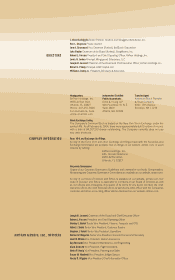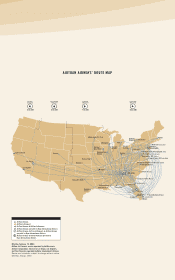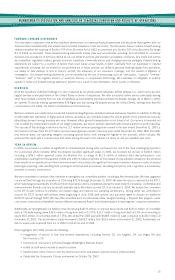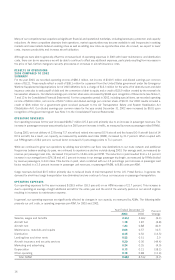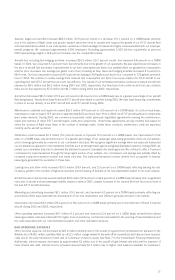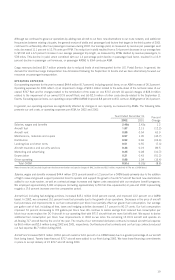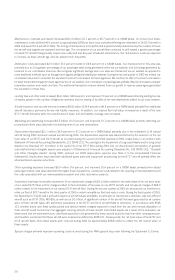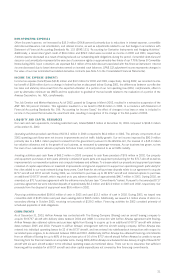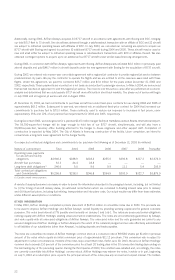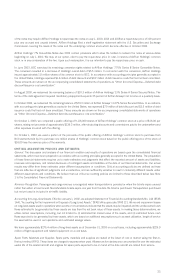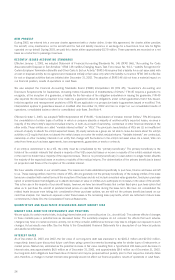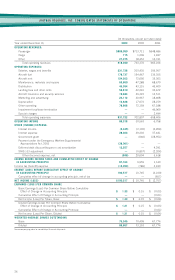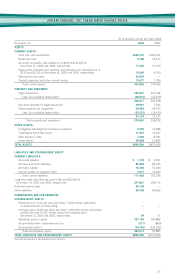Airtran 2003 Annual Report Download - page 20
Download and view the complete annual report
Please find page 20 of the 2003 Airtran annual report below. You can navigate through the pages in the report by either clicking on the pages listed below, or by using the keyword search tool below to find specific information within the annual report.INCOME TAX BENEFIT
Income tax benefit was $13.4 million and $0.8 million for 2003 and 2002, respectively. As a result of our two consecutive years of
profitable results in 2003 and 2002 and the expectation of continued profitability, we recorded a tax benefit of $15.9 million as a result
of the reversal of the valuation allowance on the deferred tax asset related to our NOL carryforwards. We maintained a valuation
allowance of approximately $4.1 million consisting of $3.3 million in AMT credit carryforwards and $0.8 million in state NOL carryforwards
that may expire without being used. During 2002, we recorded income tax benefit of $0.8 million due to a change in federal tax law
as discussed below.
The Job Creation and Worker Assistance Act of 2002 passed by Congress in March 2002 resulted in a retroactive suspension of the
AMT NOL 90 percent limitation. This legislation resulted in a tax benefit of $0.8 million in 2002. In accordance with Statement of
Financial Accounting Standards No. 109, “Accounting for Income Taxes,” the effect of changes in tax laws or rates is included in
income in the period that includes the enactment date, resulting in recognition of the change in the first quarter of 2002.
2002 COMPARED TO 2001
SUMMARY
For the year 2002, we recorded operating income of $30.6 million, net income of $10.7 million and diluted earnings per common
share of $0.15. These results reflect a credit of $0.6 million for government grant funds received pursuant to the Stabilization Act. Our
diluted earnings per common share were increased by $0.01 upon recognition of the government grant (see Note 3 to the Consolidated
Financial Statements). For the comparative period in 2001, including special items, we recorded operating income of $6.8 million, a
net loss of $2.8 million and a diluted loss per common share of $0.04. Our 2001 results were significantly affected by the terrorist
attacks on the United States that occurred on September 11, 2001 (the September 11 Events) and include: (i) special charges of $46.1
million in operating expenses that reflect reductions in aircraft fleet values, aircraft lease termination charges; and (ii) special charges
of $2.5 million directly related to the September 11 Events. Our non-operating results for 2001 included a special item of $4.3 million
representing additional debt discount amortization resulting from the exercise of conversion rights on approximately two-thirds of our
7.75% Series B Senior Convertible Notes and a credit of $29.0 million for government grant funds we expected to receive pursuant to
the Stabilization Act. Our diluted earnings per common share for the year ended December 31, 2001 were increased by $0.42 upon
recognition of the government grant (see Note 3 to the Consolidated Financial Statements).
Our passenger revenues for the period from September through December 2001 were significantly affected by the September 11
Events. In response to the terrorist attacks, the Federal Aviation Administration (FAA) immediately issued a federal ground stop order
on September 11th, which prohibited all civil aviation flights from operation within the national airspace of the United States. The U.S.
airspace was not reopened until September 13th, at which time we operated a portion of our pre-September 11th scheduled operations.
Once flights resumed, passenger traffic and yields were significantly lower than we had experienced prior to September 11th. In an
effort to match our capacity to the reduced level of demand, we reduced our operations to levels similar to those we operated during
the same period in 2000, despite the fact that we had been successful in growing our capacity by 18 percent earlier in the year. In
addition, many corporations curtailed their business travel and leisure travelers cancelled or postponed vacations, which forced airlines
to reduce airfares in an attempt to stimulate demand. Despite these actions, our traffic dropped in the post-September 11th period by
over 11 percent, which resulted in our passenger load factor declining eight percentage points compared to the previous year.
Passenger yields also suffered during the post-September 11th period declining nearly 15 percent year-over-year. This resulted in a
$51.8 million, or 25 percent, decline in passenger revenues compared to the same time period in 2000.
On September 22, 2001, President Bush signed into law the Stabilization Act, which provided, in part, for qualifying U.S. airlines and
air cargo carriers to receive: up to $5 billion in compensation for direct losses, including lost revenues, incurred as a direct result of
the FAA ground stop order and for incremental losses incurred through December 31, 2001 as a direct result of the September 11
Events; up to $10 billion in federal government loan guarantees; reimbursement for certain insurance increases; and the extension in
due dates for payment of certain excise taxes. Each air carrier was entitled to receive the lesser of its direct and incremental losses for
the period of September 11, 2001 to December 31, 2001 or its available seat mile (ASM) allocation of the $5 billion compensation. We
received compensation payments of $5.0 million and $24.6 million during 2002 and 2001, respectively. Related to these payments, we
recognized income of $0.6 million and $29.0 million in 2002 and 2001, respectively, which is included in Other (income) expense,
net—Government Grant on the accompanying Consolidated Statements of Operations.
OPERATING REVENUES
Our operating revenues for the year increased $68.2 million (10.3 percent) primarily due to an increase in passenger revenues. The
increase in passenger revenues was primarily due to a 23.9 percent increase in traffic, as measured by revenue passenger miles (RPMs).
During 2002, we took delivery of 20 Boeing 717 aircraft and retired 14 DC9 aircraft. As a result, our capacity, as measured by ASMs,
increased by 26.3 percent. When coupled with our RPM growth of 23.9 percent, our load factor declined 1.3 percentage points to
67.6 percent.
18




